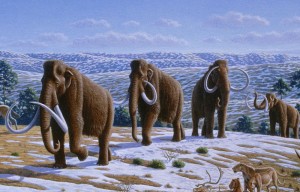From Ed Young at the Not Exactly Rocket Science blog, the opening of a post asking if we can clone a mammoth–and if we should:
“Tens of thousands of years ago, woolly mammoths roamed the northern hemisphere. These giant beasts may now be extinct, but some of their bodies still remain in the frozen Arctic wilderness. Several dozen such carcasses have now been found, and some are in extremely good condition. Scientists have used these remains to discover much about how the mammoth lived and died, and even to sequence most of its genome. But can they also bring the animal back from the dead? Will the woolly mammoth walk again?
Akira Iritani certainly seems to think so. The 84-year-old reproductive biologist has been trying to clone a mammoth for at least a decade, with a team of Japanese and Russian scientists. They have tried to use tissues from several frozen Siberian specimens including, most recently, a well-preserved thighbone. Last year, Iritani told reporters, ‘I think we have a reasonable chance of success and a healthy mammoth could be born in four or five years'” (Thanks Browser.)


